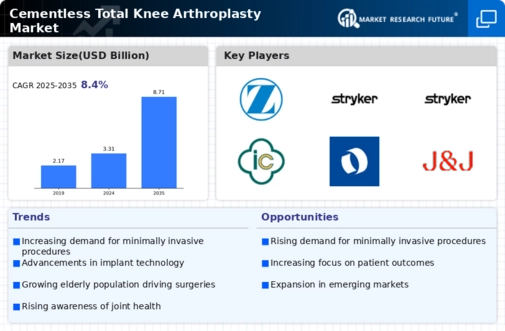Market Growth Projections
The Global Cementless Total Knee Arthroplasty Market Industry is expected to witness substantial growth over the next decade. With a projected market value of 3.31 USD Billion in 2024 and an anticipated increase to 8.71 USD Billion by 2035, the industry is poised for significant expansion. This growth is underpinned by a compound annual growth rate of 9.2% from 2025 to 2035, indicating a robust demand for innovative solutions in knee arthroplasty. Factors such as technological advancements, demographic shifts, and evolving patient preferences are likely to contribute to this upward trend, making the market an area of keen interest for stakeholders.
Rising Geriatric Population
The global demographic shift towards an aging population is a significant factor driving the Global Cementless Total Knee Arthroplasty Market Industry. As individuals age, the likelihood of developing knee-related issues increases, leading to a higher demand for knee replacement surgeries. By 2035, the market is projected to reach 8.71 USD Billion, underscoring the urgency of addressing the needs of this demographic. Healthcare systems are likely to adapt by incorporating more cementless options, which may provide enhanced stability and longevity of implants. This demographic trend suggests a sustained growth trajectory for the market in the coming years.
Increasing Prevalence of Osteoarthritis
The rising incidence of osteoarthritis globally is a primary driver for the Global Cementless Total Knee Arthroplasty Market Industry. As populations age, the demand for knee replacement surgeries is expected to surge. In 2024, the market is projected to reach 3.31 USD Billion, reflecting the growing need for effective treatment options. Osteoarthritis affects millions worldwide, leading to significant disability and impacting quality of life. This trend suggests that healthcare systems will increasingly prioritize cementless solutions, which offer potential benefits such as improved bone integration and reduced risk of implant loosening, thereby enhancing patient outcomes.
Enhanced Patient Outcomes and Satisfaction
Improved patient outcomes associated with cementless total knee arthroplasty are driving interest in the Global Cementless Total Knee Arthroplasty Market Industry. Studies indicate that patients receiving cementless implants often experience better functional recovery and lower rates of revision surgeries. This is particularly relevant as healthcare providers focus on quality of care and patient satisfaction metrics. The anticipated growth of the market, reaching 3.31 USD Billion in 2024, reflects this shift towards solutions that prioritize long-term success and patient well-being. As more positive clinical data emerges, the adoption of cementless techniques is likely to increase.
Technological Advancements in Implant Design
Innovations in implant design and materials are propelling the Global Cementless Total Knee Arthroplasty Market Industry forward. Recent advancements have led to the development of more biocompatible materials and improved surface coatings that enhance osseointegration. These technological improvements are likely to increase the adoption of cementless implants, as they may offer better long-term performance compared to traditional cemented options. The market is anticipated to grow significantly, with projections indicating a rise to 8.71 USD Billion by 2035. As surgeons become more familiar with these advancements, the shift towards cementless solutions is expected to accelerate.
Growing Awareness of Minimally Invasive Techniques
There is a notable increase in awareness regarding minimally invasive surgical techniques, which is influencing the Global Cementless Total Knee Arthroplasty Market Industry. Patients are increasingly seeking options that promise quicker recovery times and less postoperative pain. Cementless total knee arthroplasty aligns with these preferences, as it often involves less soft tissue disruption. This trend is likely to drive market growth, as more healthcare providers adopt these techniques to meet patient demands. The anticipated compound annual growth rate of 9.2% from 2025 to 2035 indicates a robust market expansion driven by these evolving patient expectations.












